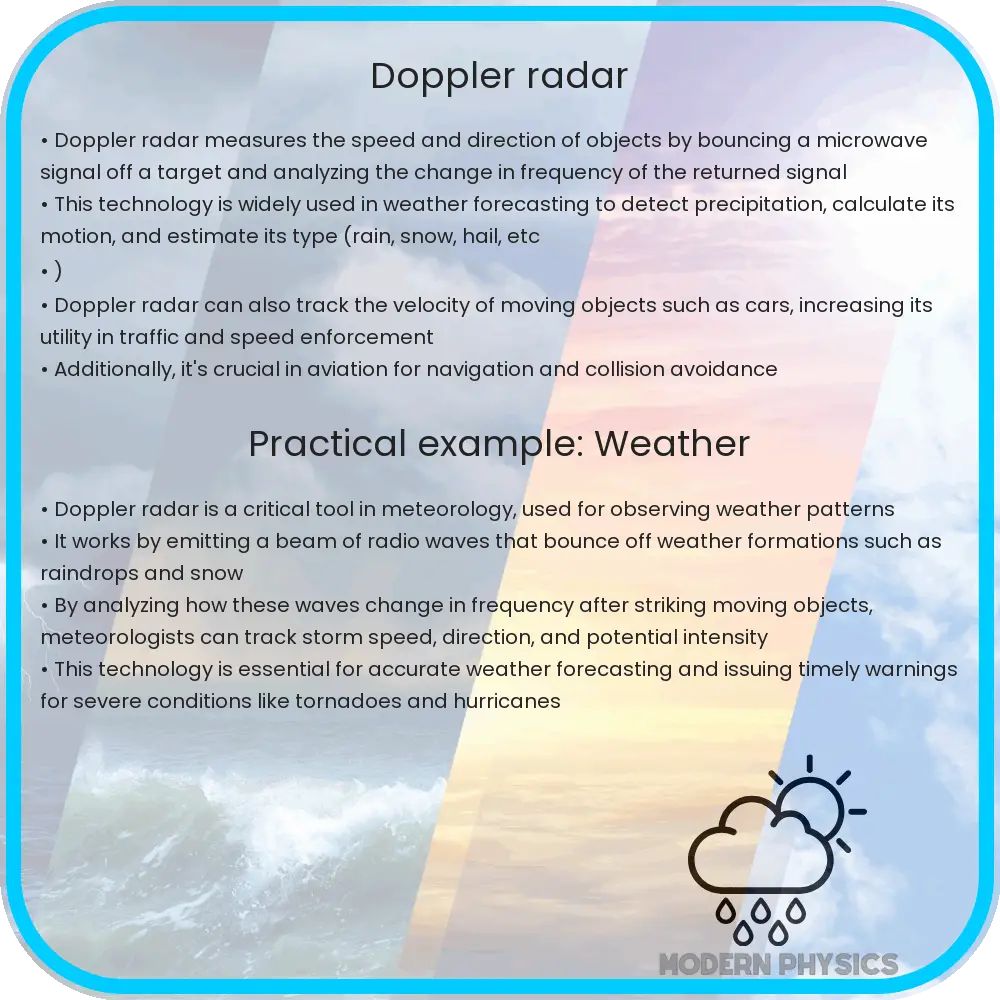An essential technology in meteorology, Doppler radar uses the Doppler effect to monitor and predict weather patterns by analyzing changes in wave frequency.

Understanding Doppler Radar: A Key Tool in Meteorology
Doppler radar is an essential technology in meteorology, primarily used for weather monitoring and forecasting. It utilizes the Doppler effect—a change in frequency or wavelength of a wave in relation to an observer who is moving relative to the wave source—to determine the velocity and location of weather systems. Let’s delve into how it works and why it’s crucial for predicting weather patterns and ensuring safety.
How Does Doppler Radar Work?
At its core, Doppler radar involves emitting a beam of energy waves, typically microwaves, which then bounce back off objects such as raindrops, snowflakes, or even hail. When these waves return, the radar system analyzes changes in their frequency. According to the Doppler effect, if the object is moving toward the radar, the frequency of the returned waves increases. If the object is moving away, the frequency decreases.
The formula to determine the frequency change, Δf, is given by:
Δf = 2f0v/c
where f0 is the emitted frequency, v is the velocity of the target relative to the radar, and c is the speed of light.
Applications in Weather Forecasting
Doppler radar has revolutionized how meteorologists predict weather. By measuring how raindrops and other precipitation move within a storm, forecasters can determine its structure, intensity, and motion. This information is critical in predicting severe weather events such as tornadoes, thunderstorms, and hurricanes.
- Precipitation Monitoring: Doppler radar helps in monitoring the type, intensity, and movement of precipitation, allowing forecasters to provide timely rain and snow forecasts.
- Storm Tracking: It facilitates the tracking of storm movement and development, especially useful for warnings about severe storms that might involve high winds or tornadoes.
- Wind Analysis: By analyzing the shifts in wave frequency, meteorologists can also assess wind speeds and patterns within the weather system, which is vital for aviation safety and planning.
Enhancing Safety with Advanced Warnings
The ability to monitor and predict severe weather conditions accurately is directly tied to enhancing safety protocols. Doppler radar provides crucial lead time for severe weather warnings, allowing both the general public and emergency responders to prepare and respond effectively. Whether it’s rerouting aircraft around severe turbulence or evacuating people from areas expected to be hit by tornadoes, the advanced warnings generated by Doppler radar are indispensable in saving lives and minimizing property damage.
The precision and real-time capabilities of Doppler radar make it instrumental in severe weather response strategies, offering a detailed look into storm dynamics that was not possible before its advent. The continuous updates allow for dynamic tracking, which is integral during sudden weather changes.
The Science Behind Doppler Radar
The effectiveness of Doppler radar in weather prediction relies heavily on understanding the physics of wave movement and the atmospheric conditions influencing these waves. Meteorologists combine Doppler data with other observational data and models to provide the most accurate weather forecasts possible.
This combination of precision technology and advanced algorithms ensures that Doppler radar remains a cornerstone of modern meteorology, helping to protect lives and enhance preparedness for severe weather events. Understanding its operation and impact is essential for appreciating how experts harness technology to forecast weather and ultimately safeguard communities.
Limits and Challenges of Doppler Radar
Despite its significant advantages, Doppler radar does face some limitations and challenges. One of the primary issues is the phenomenon known as the “radar gap. This occurs in areas where the radar beam is obstructed by geographical features such as mountains or buildings, leading to incomplete data. Also, the quality of Doppler radar data can significantly diminish with distance, as the radar beams spread out and become less sensitive to smaller particles.
- Range limitations: The effectiveness of Doppler radar decreases as the distance from the radar increases. This is because the radar’s sensitivity diminishes, making it harder to detect small or distant weather phenomena.
- Obstacles: Physical barriers can block the radar waves, leading to blind spots in radar coverage. This can be particularly problematic in mountainous or densely built-up areas.
- Temporal resolution: While Doppler radar provides data rapidly, there may still be a delay between scans, which can miss fast-changing weather conditions.
Future Advancements in Doppler Radar Technology
As technology evolves, so does Doppler radar. Researchers and engineers are continually working on enhancements to overcome existing limitations and increase the utility and accuracy of weather forecasting. Upcoming advancements include using dual-polarization technology, which provides more detailed information about precipitation structure and type. Additionally, efforts are being made to integrate artificial intelligence and machine learning to analyze the vast amount of data more efficiently and predict complex weather patterns with greater accuracy.
Another promising development is the phased array radar, which offers rapid scanning capabilities. This technology can scan the entire sky in a matter of seconds, significantly improving the temporal resolution of weather monitoring systems. These innovations promise to enhance our understanding of meteorology further and improve our ability to respond to weather-related disasters.
Conclusion
Doppler radar stands as a crucial tool in the field of meteorology, underpinning modern weather prediction and safety strategies. Its ability to analyze atmospheric movements provides vital warnings and forecasts that save lives and prevent property damage. Despite some challenges, ongoing technological improvements are poised to bridge these gaps, ushering in a new era of weather forecasting that is even more reliable and precise. Understanding the principles and applications of Doppler radar not only helps us appreciate the complexities of weather systems but also highlights the importance of continuous innovation in science and technology. By keeping communities well-informed and prepared, Doppler radar ultimately serves as a guardian against the unpredictable nature of weather.
